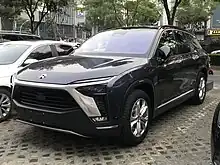Automotive industry in China
The automotive industry in China has been the largest in the world measured by automobile unit production since 2008.[1][2] Since 2009, annual production of automobiles in China accounted for more than 32% of worldwide vehicle production, exceeding both that of the European Union and that of the United States and Japan combined.[3]
| Part of a series on the |
| History of science and technology in China |
|---|
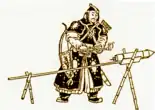 |
While most of the cars manufactured in China are sold within China, exports – accounting for 11.5% of total production – reached 3.11 million units in 2022, making the country the world's second biggest car exporter.[4] In the first half of 2023, China overtook Japan to become the world's largest exporter of automobiles, exporting 2.34 million vehicles compared to 2.02 million for Japan.[5] China's home market provides its automakers a solid base and Chinese economic planners hope to build globally competitive auto companies[6][7] that will become more and more attractive and reliable over the years.[8]
The main industry group for the Chinese automotive industry is the China Association of Automobile Manufacturers (中国汽车工业协会).
Manufacturers and brands
The traditional "Big Four" domestic car manufacturers are SAIC Motor, FAW, Dongfeng and Changan. Other Chinese car manufacturers are Geely, BAIC, BYD, Chery, GAC, Great Wall, JAC and Seres. In addition, several multinational manufacturers have partnerships with domestic manufacturers.
Central government controlled state-owned enterprises
FAW (First Automobile Works Group Corporation, Chinese: 中国第一汽车集团有限公司) is a Chinese state-owned automotive manufacturing company headquartered in Changchun which is directly under the control of central government of China. Founded the 15th July 1953, It is the oldest car manufacturer of the People's Republic of China. Currently FAW sells products under there different brands including Hongqi, Jie Fang, and Bestune. FAW also operates joint ventures with Toyota, Volkswagen and Audi.
Dongfeng (Dongfeng Motor Corporation, Chinese: 东风汽车集团有限公司) is a Chinese state-owned automobile manufacturer headquartered in Wuhan which is directly under the control of central government of China. Originally known as Second Automobile Works when it was founded in 1969, FAW and Dongfeng were the two major manufacturers before the Reform and Opening-up of China. It owns Voyah, M-Hero, Aeolus, Forthing, Dongfeng Nammi brands and operates joint ventures include Cummins, Honda, Nissan, Infiniti, and Stellantis (PSA Peugeot Citroën).
Changan (Chang'an Automobile Group, Chinese: 重庆长安汽车股份有限公司)is an automobile manufacturer headquartered in Chongqing, and is a state-owned enterprise controlled by China South Industries Group Corporation, an enterprise under the control of central government. It is the oldest automobile manufacturer in China which can be traced back to 1862 of Qing Dynasty. Changan designs, develops, manufactures and sells passenger cars sold under the Changan, Deepal, Oshan and Kaicene brand. Foreign joint venture companies include Avatr, Ford and Mazda.
Local government controlled state-owned enterprises
SAIC (Shanghai Automotive Industry Corporation, Chinese:上海汽车集团股份有限公司) is a Chinese state-owned automotive manufacturing company headquartered in Shanghai. It is controlled by the government of Shanghai. SAIC sells vehicles under a variety of brands. Brand names include IM, Rising, Maxus, MG, Roewe, Wuling, Baojun, ,Yuejin. Joint venture brands include Buick, Chevrolet, Iveco, Škoda, Volkswagen.
Chery (Chery Automobile, Chinese: 奇瑞汽车股份有限公司), a Chinese state-owned automobile manufacturer based in Anhui and controlled by the government of Wuhu City. They have a foreign joint venture with Jaguar Land Rover for the production of Jaguar and Land Rover cars in China. They also sell cars under the Chery, Exeed, Jetour and iCAR brand.
GAC (Guangzhou Automobile Corporation, Chinese: 广州汽车集团股份有限公司), is a Chinese state-owned automobile manufacturer headquartered in Guangzhou and controlled by the government of Guangdong Province. GAC sells passenger cars under the Trumpchi and Aion brand operates foreign joint-venture with Honda and Toyota.
BAIC (Beijing Automotive Industry Corporation, Chinese: 北京汽车工业控股有限责任公司), is a state-owned enterprise located Beijing and controlled by the government of Beijing City. Its owns the brands of Arcfox Beijing, Beijing Off-road, and Foton. BAIC's parent is the ). It has foreign joint ventures with Hyundai and Mercedes-Benz.
JAC (Jianghuai Automobile Corporation, Chinese: 安徽江淮汽车股份有限公司) is a state-owned enterprise based in Hefei, Anhui Province and controlled by the provincial government of Anhui. It owns the brands of JAC, Sehol and OEMs vehicles for NIO.
Private owned manufacturers
BYD (BYD Auto, Chinese: 比亚迪汽车), is an auto manufacturer based in Shenzhen, founded by BYD Company who are known for their batteries and electric buses around the world. It is currently the biggest EV manufacture of the world.
Geely (Zhejiang Geely Holding Group, Chinese: 浙江吉利控股集团有限公司), is the one of the biggest privately owned automobile manufacturer headquartered in Taizhou, Zhejiang. Currently one of the fastest growing automotive groups in the world, Geely is known for its ownership of the Swedish luxury car brand Volvo Cars, its performance counterpart Polestar, and the British sports car company Lotus. In China, their passenger car brands include Geely, Livan, Lynk & Co, Zeekr, Volvo Cars, Polestar, Lotus, LEVC, Farizon, Radar, Ji Yue and operate joint venture with Proton and Smart.
GWM (Great Wall Motor, Chinese: 长城汽车股份有限公司), private company famous for manufacturing SUVs headquartered in Baoding, Hebei. Great Wall sells vehicles under the brands of Haval, Wey, Tank and Ora. It operate a joint-venture called Spotlight Automotive with BWM Group to produced electric Mini vehicle.
Seres (Seres Group, Chinese: 赛力斯集团), is a private manufacturer headquartered in Chongqin. It used to be famous for producing light commercial vehicles and budget passenger vehicle. Backed by Chinese tech giant Huawei, Seres is transforming to producing premium electric vehicle since 2021. It owns the brand of Seres, AITO, Fengon and DFSK.
Foreign manufacturer and joint ventures
Since the initiation of reform and opening-up in China, almost all major international automobile manufacturers have entered the Chinese market through joint ventures. China has improved its industrial capabilities by absorbing advanced foreign technologies and management practices. Since 2010s, some foreign manufacturers and brands gradually exited the Chinese market due to their lack of competitiveness, such as Suzuki, Mitsubishi, FCA (Jeep, Fiat, Chrysler), Renault, PSA (DS) etc.
Foreign manufacturers
Until 2017, Chinese automotive policy required that a foreign carmaker must form a joint-venture with a Chinese carmaker if the former plans to sell its electric vehicles, with the Chinese carmaker owning 51% of the joint venture. However, since 2017, the Chinese government had indicated that it would liberalize foreign control in the automotive sector, allowing full ownership by foreign companies.[9]

In 2017, Tesla has been allowed to set up a plant in Shanghai city, make it the first foreign automaker to open a wholly owned factory in China. In 2022, BMW and Volkswagen had acquired 75% stake in their joint ventures, which enables them to have the majority control of its Chinese joint ventures.
- Tesla
- Gigafactory Shanghai (currently the only fully foreign owned car manufacturer in Mainland China)
- BMW
- BMW Brilliance (joint-venture with Brilliance Auto Group, a majority 75% stake was acquired by BWM in 2022)
- Volkswagen Auto Group
- Volkswagen Anhui (joint-venture with JAC, a majority 75% stake was acquired by Volkswagen in 2020)
Joint-venture manufacturers
Since the Reform and Opening-up in 1980s, Chinese government only allowed a foreign car manufacturer to partner with at most two Chinese car companies to produce cars locally. This restriction is to be loosened by 2022, and is already loosened for 'new energy' vehicle corporations. Volkswagen, for example, has already established three joint ventures (VW-JAC has been majority acquired by VW).
_260TURBO_front.jpg.webp)
- Volkswagen Auto Group
- General Motors
- SAIC-GM (with SAIC) (Cadillac, Buick, Chevrolet)
- SAIC-GM-Wuling (with Wuling, SAIC)
- Ford
- Changan Ford (with Changan)
- Jiangling Ford (with Jiangling Motors)
- Stellantis
- Dongfeng PSA (with Dongfeng) (Peugeot, Citroën)
- Renault-Nissan-Mitsubishi
- Dongfeng Nissan (with Dongfeng) (Nissan, Infiniti, Venucia)
- Zhengzhou Nissan (with Dongfeng)
- Toyota
- FAW Toyota (with FAW)
- GAC Toyota (with GAC)
- Mercedes-Benz Group
- Beijing Benz (with BAIC)
- Fujian Benz (with BAIC, Fujian Motors)
- Honda
- Dongfeng Honda (with Dongfeng)
- Guangzhou Honda (with GAC)
- Hyundai-Kia
- Yueda Kia (with Yueda)
- Beijing Hyundai (with BAIC)
- Isuzu
- Jiangxi Isuzu (with Jiangling)
- Qingling Motors (with Qingling)
- Tata Group
- Chery Jaguar Land Rover (with Chery)
- Mazda
- Changan Mazda (with Changan)
| Year | State-owned | Private owned | ||||||||||
|---|---|---|---|---|---|---|---|---|---|---|---|---|
| FAW | Dongfeng | Changan | SAIC | GAC | BAIC | JAC | Chery | Geely | BYD | GWM | Seres | |
| 2010 | 1,038,290 | 607,068 | 1,316,557 | 1,424,513 | 45,065 | 682,895 | 442,547 | 750,456 | 425,194 | 521,761 | 415,779 | 226,198 |
| 2011 | 907,337 | 654,991 | 987,991 | 1,433,387 | 44,056 | 664,812 | 466,459 | 729,497 | 857,006 | 454,676 | 518,965 | 243,053 |
| 2012 | 718,327 | 611,446 | 950,568 | 1,659,973 | 71,505 | 683,991 | 448,813 | 653,476 | 905,083 | 462,512 | 672,234 | 202,991 |
| 2013 | 723,969 | 709,470 | 990,556 | 1,884,112 | 124,001 | 866,994 | 495,737 | 561,062 | 979,691 | 514,188 | 803,449 | 205,019 |
| 2014 | 627,006 | 715,344 | 1,126,011 | 2,051,240 | 146,694 | 864,783 | 446,802 | 570,718 | 878,818 | 446,329 | 767,825 | 277,000 |
| 2015 | 505,849 | 690,531 | 1,270,154 | 2,272,961 | 207,890 | 827,170 | 588,052 | 575,108 | 1,025,287 | 451,868 | 871,315 | 275,316 |
| 2016 | 505,711 | 779,298 | 1,382,917 | 2,533,586 | 375,723 | 988,109 | 643,342 | 682,474 | 1,333,077 | 510,157 | 1,086,639 | 381,636 |
| 2017 | 572,862 | 810,407 | 1,327,168 | 2,811,224 | 508,797 | 837,129 | 510,892 | 604,708 | 1,867,066 | 421,158 | 1,085,654 | 400,038 |
| 2018 | 543,986 | 664,313 | 1,139,540 | 2,957,136 | 535,323 | 701,754 | 462,477 | 752,759 | 2,212,102 | 528,298 | 1,072,529 | 347,837 |
| 2019 | 589,832 | 661,585 | 1,060,676 | 2,621,117 | 384,792 | 743,614 | 421,241 | 747,806 | 2,093,962 | 467,960 | 1,097,451 | 325,381 |
| 2020 | 779,403 | 721,332 | 1,306,169 | 2,575,775 | 353,597 | 790,241 | 456,125 | 731,117 | 2,040,418 | 431,447 | 1,111,598 | 273,590 |
| 2021 | 846,803 | 819,172 | 1,557,282 | 2,811,922 | 447,207 | 760,476 | 524,224 | 961,926 | 2,105,560 | 749,325 | 1,280,993 | 266,614 |
| 2022 | 554,260 | 743,032 | 1,874,569 | 2,784,581 | 633,704 | 570,681 | 500,401 | 1,232,727 | 2,293,652 | 1,881,669 | 1,102,322 | 267,246 |
| Year | Li Auto | Nio | Xpeng | Hozon | Leapmotor | AITO[11] | Avatr |
|---|---|---|---|---|---|---|---|
| 2018 | - | 11,348 | 482 | 1,206 | - | - | - |
| 2019 | 1,000 | 20,565 | 16,608 | 11,212 | 1,000 | - | - |
| 2020 | 33,457 | 43,728 | 27,041 | 15,509 | 10,266 | - | - |
| 2021 | 90,491 | 91,429 | 98,155 | 69,674 | 43,121 | - | - |
| 2022 | 133,246 | 122,486 | 120,757 | 152,073 | 111,168 | 76,180 | 757 |
| Year | Production | Domestic share | Global share |
|---|---|---|---|
| 2010 | 6,273,000 | 45.6% | 7.96% |
| 2011 | 6,112,200 | 42.2% | 7.24% |
| 2012 | 6,485,000 | 41.9% | 7.23% |
| 2013 | 7,222,000 | 40.3% | 8.03% |
| 2014 | 7,518,000 | 38.1% | 8.28% |
| 2015 | 8,737,600 | 41.3% | 9.27% |
| 2016 | 10,529,000 | 43.2% | 10.96% |
| 2017 | 10,847,000 | 43.9% | 11.15% |
| 2018 | 9,890,000 | 42.1% | 10.35% |
| 2019 | 8,470,000 | 39.2% | 9.17% |
| 2020 | 7,749,000 | 38.4% | 9.83% |
| 2021 | 9,543,000 | 44.4% | 12.06% |
| 2022 | 11,943,200 | 50.7% | 15.04% |
History
China's automobile industry can be traced back to the early origin of Changan Automobile in 1862 when Li Hongzhang set up a military supply factory, the Shanghai Foreign Gun Bureau.[13][14] The first automobile in China was purchased from Hong Kong in 1902 by Yuan Shikai and gifted to Empress Dowager Cixi. It was later put on display in the Summer Palace Museum. During the early twentieth century, major western automobile manufacturers such as the Ford Motor Company, General Motors, and Mercedes-Benz had plants operating in Shanghai.
However, the War of Resistance against Japanese Aggression of 1937 hampered the progress of the Chinese auto industry, as seen by the relocation of the Changan Automobile factory from Shanghai to Chongqing in the wake of the city's bombing and attack.[15] After the foundation of the People's Republic of China in 1949, plants and licensed auto design were established in China with assistance from the Soviet Union in the 1950s, marking the beginning of the country's rapidly expanding automobile sector. However, the Chinese automotive industry had small volumes for the first 30 years of the republic, not exceeding 100–200 thousand per year. Since the early 1990s, it has developed rapidly. China's annual automobile production capacity first exceeded one million in 1992. By 2000, China was producing over two million vehicles. After China's entry into the World Trade Organization (WTO) in 2001, the development of the automobile market accelerated further. Between 2002 and 2007, China's national automobile market grew by an average 21 percent, or one million vehicles year-on-year.[16] In 2009, China produced 13.79 million automobiles, of which 8 million were passenger cars and 3.41 million were commercial vehicles and surpassed the United States as the world's largest automobile producer by volume. In 2010, both sales and production topped 18 million units, with 13.76 million passenger cars delivered, in each case the largest by any nation in history.[17] In 2017, total vehicle production in China reached 28.879 million, accounting for 30.19% of global automotive production.[18] In 2023, China overtook Japan and became the world largest car exporter.[19]
| Year | Production | Global share | Milestones |
|---|---|---|---|
| 1955 | 61 | Foundation of the First Automobile Works (FAW) | |
| 1960 | 22,574 | ||
| 1970 | 87,166 | ||
| 1978 | 149,062 | Beginning of the Reform and Opening-up | |
| 1985 | 443,377 | ||
| 1990 | 509,242 | ||
| 1995 | 1,452,697 | ||
| 2002 | 3,250,000 | 5.6% | Accession to the World Trade Organization (WTO) |
| 2005 | 5,710,000 | 8.6% | |
| 2009 | 13,790,000 | 25.0% | Surpassing the United States as the world's largest automobile producer |
| 2010 | 18,260,000 | 24.2% | The largest number of production by any nation in history |
| 2015 | 24,500,000 | 27.43% | Became the world largest EV producer |
| 2017 | 29,020,000 | 30.19% | The highest production record in history |
| 2022 | 27,021,000 | 31.8% | Surpassing Germany as the world's second largest car exporter |
The dawn of industrialization (1928 to 1949)
The first Chinese built motor vehicle was a truck called the Ming Sheng. It was designed by Daniel F Myers and a prototype was made at the Liao Ning Trench Mortar Arsenal, Shenyang. The prototype was completed on May 31, 1931, for Zhang Xueliang. Prior to production commencing, the factory was bombed by the invading Japanese and production never commenced.[22] A fellow general, Yang Hucheng, patronized the inventor Tang Zhongming to make a new type of automobile engine powered by charcoal. In 1932 Tang founded the Chung Ming Machinery Co. Ltd. in Shanghai to produce the engines. Charcoal powered vehicles were mainly used during the Second Sino-Japanese War in China because of fuel shortages.[23] Tung oil was also used during the war as a petroleum substitute.[24] One source states that Du Yuming designed a car in 1937, but did not make it until 1943 after having been forced to move because of the war. No further information has been found about it.[25]
The socialist revolution era (1949 to 1980)
.jpg.webp)
The development of the Chinese automobile industry during this period was relatively slow due to the lack of free market competition and turbulence of socialist political movement like Culture Revolution. Except for a certain degree of development in the 1950s with assistance from the Soviet Union, the Chinese automobile industry remained closed and lagging behind until the period of Reform and Opening-up. Most domestically produced vehicles were primarily the Jiefang trucks for military or industrial department and the Hongqi sedans used by a limited number of government officials. The concept of private cars had not yet emerged in China during this period.
.jpg.webp)
Since the foundation of the People's Republic of China, several vehicle assembly factories were set up in the 1950s and 1960s. They were Beijing (today's Beijing Automotive Industry Holding Corporation), Shanghai (today's Shanghai Automotive Industry Corporation), Nanjing (later Nanjing Automobile (Group) Corporation, merged with SAIC), and Jinan (evolving into China National Heavy Duty Truck Group). The Second Automobile Works (later Dongfeng Motor Corporation) was founded in 1968.
The first Chinese production vehicles were trucks made by the First Automobile Works in 1956, called the Jiefang CA-10.[26] This was followed on March 10, 1958, by the 2½ ton light duty truck (NJ130), which was based on the Russian GAZ-51, was produced in Nanjing. The truck was named Yuejin (meaning "leap forward") by China's First Ministry of Industrial Machinery.
In June 1958 the Nanjing Automobile Works, previously a vehicle servicing unit of the Army, was established. Production continued until the last truck (NJ134) rolled off the assembly line on July 9, 1987. Cumulative production was 161,988 units (including models NJ130, NJ230, NJ135 and NJ134). The first production automobiles were the Dongfeng CA71, Hongqi CA72, Feng Huang (later known as the Shanghai SH760) all from 1958.
The reform and opening-up and foreign investment (1980 to 2000)
Chinese economic reform in 1978 have brought tremendous opportunities for the development of the Chinese automotive industry.
- Impact of foreign cars
The passenger car industry was a minor part of vehicle production during the first three decades of China's socialist economy. As late as 1985, the country produced a total of only 5,200 passenger cars. Car sales increased dramatically, although they were almost entirely purchased by danweis (work units – private car ownership was virtually unknown at the time).[27]
As domestic production was very limited, import totals rose dramatically, despite a 260 per cent import duty on foreign vehicles. Before 1984, the dominant exporter of cars to China had been the Soviet Union. In 1984, Japan's vehicle exports to China increased sevenfold (from 10,800 to 85,000) and by mid-1985 China had become Japan's second biggest export market after the US.[28] The country spent some $3 billion to import more than 350,000 vehicles (including 106,000 cars and 111,000 trucks) in 1985 alone. Three taxi companies in particular thirsted for Japanese cars, such as Toyota Crowns and Nissan Bluebirds.[29]
As this spending binge began to lead to a severe trade deficit, the Chinese leadership put on the brakes, through the adjustment of import and foreign exchange policies.[30] Customs duties on imported goods were raised in March 1985 and a new "regulatory tax" was added a little later. In September 1985, a two-year moratorium on nearly all vehicle imports was imposed.[30]
- Emergence of joint ventures and "market for technology" policy
In July 1979, China adopted its first Law on Joint Venture Using Chinese and Foreign Investment. This law was effective in helping to attract and absorb foreign technology and capital from developed countries like the United States, facilitated China's exports to such countries, and thereby contributed to China's subsequent rapid economic growth.[31]
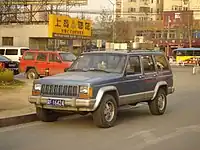
While limiting imports, China also tried to increase local production by boosting the various existing joint-venture passenger car production agreements, as well as adding new ones. In 1983, American Motors Corporation (AMC, later acquired by Chrysler Corporation) signed a 20-year contract to produce their Jeep-model vehicles in Beijing. The following year, Germany's Volkswagen signed a 25-year contract to make passenger cars in Shanghai, and France's Peugeot agreed to another passenger car project to make vehicles in the prosperous southern city of Guangzhou.[29] These early joint ventures did not allow the Chinese to borrow much foreign technology, as knock-down kit assembly made up the majority of manufacturing activities;[32] tooling may not have been allowed to slip past borders.
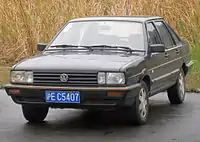
Until the late 1990s, there were eight joint venture enterprises in China producing passenger cars, including Shanghai Volkswagen, FAW-Volkswagen, Beijing Jeep, Guangzhou Peugeot, Dongfeng Citroën, Changan Suzuki, Changhe Suzuki, and Southeast Motor.
- The Five Year Plan and progress in domestic supply chain
In April 1986, the "Seventh Five-Year Plan (1986-1990)" officially proposed: "To consider the automobile manufacturing industry as a crucial pillar industry." It had a profound and positive impact on the Chinese automotive industry by recognizing it as a key national pillar industry, driving rapid industry growth, fostering domestic market prosperity, enhancing international competitiveness, and promoting technological innovation and sustainable development.[33]

The Chinese automotive industry gradually moved away from the manual workshop model and embraced Western advanced technologies and quality control management. Over the course of a decade, through digestion and absorption, the localization rate of Chinese automotive components significantly increased. In 1997, the localization rate of the SAIC-VW Santana, one of the most popular sedan in China then, jumped from 60.09% six years prior to over 90%, with key components like the car body, engine, transmission, and front and rear axle assemblies all achieving localization. The localization rate of the FAW-VW Audi 100 reached 93%, while the Jetta achieved an 84.02%. The localization rate of the Citroën Fukang by FAW exceeded 80%. The improvement in the localization rate of complete vehicles was made possible by the emerging prowess of complementary enterprises in the industry chain. Renowned automotive components today, such as diesel engines from Yuchai Machinery Factory and automotive glass from Fuyao, had their beginnings during this period.[34]
Several enterprises entered the automobile industry since 1994. Some of them are originated from defense industry, such as Chang'an Motors, Changhe, and Hafei Motor; some were developed from old state-owned companies, such as BYD Auto, Brilliance China Auto, Chery Automobile, and Changfeng Automobile. Others are private-owned companies, such as Geely Automobile and Great Wall Motors.
The explosive growth and expansion (2000 to 2020)
- Tsunami of entering the WTO
_JL6360E1%252C_front_8.12.18.jpg.webp)
With China's accession to the WTO in 2001, automotive tariffs began to be substantially reduced, leading to a decrease in the prices of imported cars. Foreign automotive giants brought a multitude of their latest models into China. According to WTO regulations, starting from 2006, the import tariffs on complete vehicles in China were lowered from the previous 30% to 28%. In 2010, they were further reduced to 25%. Tariffs on automotive components like transmissions, shock absorbers, radiators, clutches, and steering units decreased from 13.5% to 12.9% and eventually to 10%.
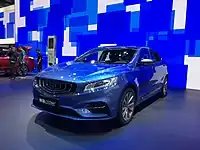
China's entry into WTO brought about increased competition from domestic
and foreign automotive brands. Amidst this intense competition, the prices in the domestic automotive market continued to decline. The annual average reduction in car prices has exceeded 8%, with a particularly significant decrease of 13.5% in 2004.[36][37]
- The rapid growth

The Chinese automotive market experienced explosive growth after 2000, becoming the largest automotive market globally. This growth is closely tied to China's economic development and the rise of the middle class. An increasing number of Chinese households can afford cars, leading to a surge in sales. China's automobile production surged from 2 million vehicles in 2000 to 29 million vehicles in 2017, marking a growth of over fourteen fold. Its global market share rose from 3% to 30%, achieving remarkable growth. China has become the largest auto producer in human history, surpassing the combined production of traditional developed countries like the United States, Japan, and Europe. [21]
In 2017, there were 300.3 million registered vehicles in China.[39]
- Intensified competition
In the 2010s, with the rapid growth of China's automobile production, China became the country with the most diverse range of automotive brands globally. Apart from mainstream joint-venture brands dominating the mid-to-high-end market, there was a substantial presence of local state-owned and private small and medium-sized automotive companies. However, after 2018, an increasing number of these smaller brands became 'zombie company' state, with many suspending production and operations, as market-driven consolidation accelerated. The number of Chinese automotive brands increased from just over 20 in the early 1990s to 84 in 2019.[41]
On February 29, 2016, the Ministry of Industry and Information Technology shut down 13 automobile manufacturers that did not meet mandatory production evaluations for two consecutive years.[42]
According to research by investment bank Goldman Sachs, newly opened Chinese car plants are the most robotized of such facilities worldwide.[43][44]
- The "corner overtaking" strategy of new energy vehicle
In 2009, the State Council of China issued the "Automobile Industry Adjustment and Revitalization Plan," which emphasized "Using new energy vehicles as a breakthrough, strengthening independent innovation to establish new competitive advantages." It explicitly outlined and anchored China's plan to use new energy vehicles as a catalyst to surpass the Western traditional automotive powerhouses, breaking their dominance in internal combustion engine technology. This strategy is commonly referred to as the "corner overtaking strategy" in the Chinese automotive industry.[46]
The strategy is a success. In 2010, China's sales of new energy vehicles(NEV) were only 5,000 units. By 2015, the sales had surged to 331,000 units. Since 2016, China has consistently maintained its position as the world's leader in terms of the total stock of NEVs and annual additions. The annual compound growth rate of production and sales of NEV has consistently remained at around 50%. In 2020, China achieved a milestone with NEV sales reaching 1.367 million units, accounting for more than 50% of globe market share.[47][48]
The steps towards world leader (2020-present)
- Establishment of technological superiority
Amidst the fierce domestic competition in China's domestic market, the world's largest automotive market, the competitiveness of the Chinese automotive industry chain continues to rise, gradually gaining a leading position in technology. The reputation of Chinese carmakers has rapidly shifted, from being seen as making low-quality knock-offs to becoming a true rival for Western brands. Chinese automakers have established the building blocks for future competitiveness in EV technology, software, digitalization, factor cost and supply chain areas.[49]
- "Reversed" joint ventures of Western manufacturers
.jpg.webp)
China's domestic brands are leading the market in the development and implementation of advanced assisted driving systems, capitalizing on their early-entry advantages in the electric and intelligent vehicle sector.[50]
As in the 1990s, Chinese automotive manufacturers sought Western technology for joint ventures, a reversal occurred in the 2020s. Western manufacturers, began seeking technological support from Chinese manufacturers to establish joint ventures. Dozens of Chinese EV startup ventures have raised with technological advantages which attracted the investment from traditional western auto giants. Renault-Nissan, VW, BMW, Mercedes-Benz, Toyota and Stellantis.

In 2017, Renault-Nissan and Dongfeng decided to set up a joint venture call "eGT New Energy Automotive" to produce A-segment EV. [51]
In 2019, Mercedes-Benz announced the establishment of a joint venture partnership with Chinese automaker Geely.[52] Geely acquired 50% of Smart brand to produce EV based on Geely's SEA platform.[53]
In 2020, BMW and Great Wall Motor invested RMB 5.1 billion on a joint venture, Spotlight Automotive, to produce the Mini brand EV using the technology of Great Wall Motor.[54]
In 2020, Toyota announced its joint venture with Chinese battery giant BYD, to provide battery for Toyota's EV. [55] The joint venture supplied the battery for Toyota bZ3, the first electric sedan of Toyota.
In July 2023, Audi and SAIC announced their partnership that the EV platform from IM Motors, the brand of SAIC, will be introduced into Audi's electric models.[56]
In July 2023, Volkswagen Group announced its investment of $700 million in XPeng, the EV startup venture from China, for purchasing 4.99% stake of the company. The VW will collaborate with XPeng to develop two VW brand electric models for the mid-size segment in the Chinese market in 2026.[57][58]
In October 2023, Stellantis announced its investment to Leapmotor at the price of 1.5 billion Euro, acquiring 20% of Leapmotor for the support of technology to built EV.[59]
| Year | Foreign manufacturer | Chinese manufacturer | "Reversed" JV/Investment/technology transfer |
|---|---|---|---|
| 2017 | Renault/Nissan | Dongfeng | Producing A-segment EV for Renault and Dacia |
| eGT New Energy Automotive (25:25:50) | |||
| 2019 | Mercedes-Benz | Geely | Producing Smart brand EV, 50% of Smart brand was acquired by Geely |
| Smart (50:50) | |||
| 2020 | BMW | Great Wall Motor | Producing Mini brand EV |
| Spotlight Automotive (50:50) | |||
| 2020 | Toyota | BYD | Supply of battery to Toyota's EV |
| BYD Toyota EV Technology (50:50) | |||
| 2023 | Volkswagen | XPeng | 4.99% of Xpeng acquired by VW;
Purchase Xpeng platform/rebadge of Xpeng to VW |
| 2023 | Audi | IM Motors | Purchase IM platform/rebadge of IM to Audi |
| 2023 | Stellantis | Leapmotor | 20% of Leapmotor acquired by Stellantis; Purchase Leapmotor platform/rebadge of Leapmotor |
| Leapmotr International (51:49) | |||
- Suppression from the West
Starting in 2020, China's automobile exports began to rapidly expand in global market. The rapid expansion of Chinese automobiles in Western countries is often perceived by Western nations as "invasion" and "threat" which caused alert and suppression by some western countries.
Professor Jim Saker, the president of the Institute of the Motor Industry in the UK, describe the Chinese car in UK as "invasion by trojan horse" and alleges there are "major security issues" with Chinese cars, that "paralysing a country."[60]
In September 2023, European Commission President Ursula von der Leyen announced EU would launch an anti-subsidy investigation into Chinese electric vehicles, claimed "Global markets are now flooded with cheaper Chinese electric cars. And their price is kept artificially low by huge state subsidies. This is distorting our market" [61], though the average price of Chinese EV in EU market is significantly higher than they are in domestic market China. Chinese government believes that the investigation proposed by the EU is a practice of pure "protectionism," to protect the EU's own industry in the name of "fair competition."[62]
Carlos Tavares, the CEO of Stellantis called the influx of Chinese car-makers an "invasion" and warmed the "possibility of geopolitical tensions" with China in 2022.[60][63] However, when Stellantis invested 1.5 billion Euro to acquired stakes of Chinese startup venture Leapmotor in 2023, he said Stallantis could benefit from "Leapmotor's competitiveness both in China and abroad".[64]
Alternative fuel vehicles

.jpg.webp)
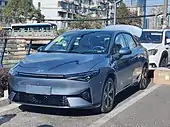
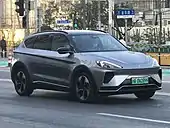

China encourages the development of clean and fuel efficient vehicles in an effort to sustain continued growth of the country's automobile industry (see Fuel economy in automobiles). By the end of 2007, China plans to reduce the average fuel consumption per 100 km for all types of vehicles by 10%. The proportion of vehicles burning alternate fuel will be increased to help optimize the country's energy consumption. Priority will be given to facilitating the research and development of electric and hybrid vehicles as well as alternate fuel vehicles, especially CNG/LNG. Major cities like Beijing and Shanghai already require Euro-3 emission standards. On March 10, 2008, Beijing became the first city to require light-duty vehicles to meet China-4 emission standard, which was equivalent to Euro-4. Beijing shifted its emission standards to the fifth-stage standards for light-duty and heavy-duty vehicles in January 2013 and August 2015, respectively. On 12 April 2016, the Ministry of Environmental Protection (MEP) released the proposal for light-duty China-6 standard.
Electric vehicles (EV) and Fuel cell vehicles (FCV)
Due to serious air pollution problems and ever-increasing traffic, alternative-energy vehicle production is an area of strong focus for the Chinese government, and several NEV-friendly policies have appeared at the national and local level as a result. In many cities, free licenses — otherwise a significant expenditure for traditional vehicles — are provided for electric vehicle owners, along with exemptions for registry lotteries. These kinds of policies have created strong interest in new energy vehicles within China.
The Chinese Automotive Industry Plan, announced on the main Web site of China's central government, said China aims to create capacity to produce 500,000 new energy vehicles, such as battery electric cars and plug-in hybrid vehicles. The plan aims to increase sales of such new-energy cars to account for about 5% of China's passenger vehicle sales.[65] At the 2010 Beijing Motor Show, more than 20 electric vehicles were on display, most of which came from native automakers. As of May 2010, at least 10 all-electric models have been reported to be on track for volume-production.[66] The first mass-produced plug-in hybrid car (BYD F3DM), all-electric minivan (BYD e6) and all-electric long-range bus (BYD K9) are Chinese.
New energy vehicle sales between January 2011 and March 2016, totaled 502,572 units, of which, over 92% were sold between January 2014 and March 2016. These figures include heavy-duty commercial vehicles such as buses and sanitation trucks. These figures only include vehicles manufactured in the country as imports are not subject to government subsidies. As of March 2016, the Chinese stock of plug-in electric vehicles consist of 366,219 all-electric vehicles (72.9%) and 136,353 plug-in hybrids (27.1%).[67][68][69][70][71][72]
As of December 2015, China is the world's largest electric bus market, and by 2020, the country was expected to account for more than 50% of the global electric bus market.[73] China also is the world's leader in the plug-in heavy-duty segment, including electric buses, plug-in trucks, particularly sanitation/garbage trucks.[74][75]
A September 2018 update by CNBC included a prediction that the market share of China's electric vehicles will grow by 40% in the short term and that China expected total annual sales of electric and gasoline-electric hybrid vehicles to be 2 million by 2020.[76] The government was encouraging the purchase of such cars with a short wait time for a new license plate and with government-backed discounts of up to 40% on electric vehicles.[77] In 2018, new-energy vehicles accounted for about 3% of China's new car sales; that was expected to increase to over 30% by 2030 according to an estimate by the Japanese Mizuho Bank.[78]
The country has a significant benefit over others. Some two-thirds of the world's lithium-ion batteries are made in China and the country's EV manufacturing facilities are close to the source these components. In October 2018, Tesla purchased land for the construction of an EV manufacturing plant in Shanghai's Lingang area.[79][80] By then, VW had already begun construction of its EV factory, with a planned annual capacity of 300,000 SAIC-VW MEB-platform vehicles, starting with three battery-electric vehicles and two plug-in hybrids.[81][82] Toyota Motor had already launched sales of an EV branded under Guangzhou Automobile Group; the two companies have a joint venture in China.[78]
Sales
In China, authorized car dealership are called 4S car shops. The 4S represents Sales (整車销售 ), Spare parts (零配件), Service (售後服务) and Survey (信息反馈).
In most cases, brand-name new cars can only be purchased from 4S shops. For new cars in high demand, a high premium is added for instant delivery or just placing an order.
The profit of car dealers in China is quite high compared to the rest of the world, in most cases 10%. This is supposedly due to the 'non-transparent invoice price' as announced by manufactures and to the premiums they charge for quick delivery. Due to the lack of knowledge for most customers, dealers can sell add-ons at much higher prices than the aftermarket.
There is no regulation by either the government or associations but some retailers are members of the China Automobile Dealers Association (CADA).[83]
Exports
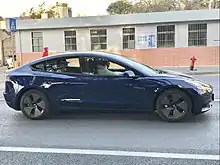
As of 2012, exports of Chinese automobiles were about 1 million vehicles per year and rapidly increasing. Most sales were made to emerging economies such as Afghanistan, Algeria, Brazil, Chile, Colombia, Costa Rica, Ecuador, Egypt, Iraq, Iran, Libya, Mexico, North Korea, Peru, the Philippines, Russia, Saudi Arabia, South Africa, or Turkey[84] where a Chinese-made automobile such as a Geely, Great Wall, or Chery sells for about half of what a comparable model manufactured by a multinational brand such as Toyota does. Cars made in China by multinational joint ventures are generally not exported. The quality of Chinese cars is increasing rapidly but, according to J. D. Power and Associates in 2012, it was not expected to reach parity with multinational manufacturers until about 2018.[85]
Most of cars manufactured in China are sold within the country; in 2011, exports totalled 814,300 units.[84] China's home market provides its automakers a solid base and Chinese economic planners hope to build globally competitive auto companies[6][7] that will become more and more attractive and reliable over the years.[8] In 2017, the country exported roughly 891,000 vehicles.[86] In that year, the value of exports was nearly $70 billion in auto parts and $14 billion in cars, while total imports (parts and vehicles) totaled about $90 billion.[87]
In 2022, Chinese car exports reached 3.11 million units, ranking second worldwide. Domestic sales still accounted for the bulk of the 27 million units produced. Electric cars sales totaled 679,000.[4] In 2023, China overtook Japan, becoming the largest car exporter in the world. The increased export numbers contributed to the growing demand for electric cars.[19]
| Year | Total | Passenger vehicle | Commercial veichle |
|---|---|---|---|
| 2010 | 544,900 | 283,000 | 261,900 |
| 2011 | 814,000 | 476,100 | 338,200 |
| 2012 | 1,056,100 | 661,200 | 394,900 |
| 2013 | 977,300 | 596,300 | 381,000 |
| 2014 | 910,400 | 533,000 | 377,300 |
| 2015 | 699,400 | 345,400 | 354,000 |
| 2016 | 708,000 | 477,000 | 231,000 |
| 2017 | 891,000 | 639,000 | 252,000 |
| 2018 | 1,041,000 | 758,000 | 283,000 |
| 2019 | 1,024,000 | 725,000 | 299,000 |
| 2020 | 995,000 | 760,000 | 235,000 |
| 2021 | 2,015,000 | 1,614,000 | 402,000 |
| 2022 | 3,111,000 | 2,529,000 | 582,000 |
Controversies
Copying claims controversy
Several Chinese car makers have been accused of copying designs of other established companies, mainly during 2000s to 2010s. Some BYD models have historically appeared similar to those of other brands including Lexus,[88] Toyota,[89][90] Honda,[91] Mercedes Benz,[92][93][94] and Porsche.[95] GM executives claimed design duplication of the Chery QQ to the Daewoo Matiz,[96] which may extend to interchangeable parts.[97] Jaguar Land Rover regarded the Landwind X7 as a copy of the Range Rover Evoque which lead to a lawsuit from Jaguar Land Rover, who subsequently won the case. German automaker Porsche threatened Zotye with legal action after it revealed the Zotye SR9 in 2016, which is said to resemble the Porsche Macan.[98] The car has been described as a "complete knockoff", with many aspects of the exterior and interior resembling the Macan.[99]

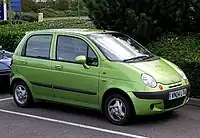
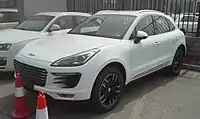
_S_wagon_(2015-08-24).JPG.webp)
Allegations of technology transfer
In 2010, The Wall Street Journal reported that the government of China was considering plans that will force foreign carmakers to disclose their electric vehicle technology secrets in exchange for access to the Chinese huge market.[100] Until 2017, Chinese automotive policy required that a foreign carmaker must form a joint-venture with a Chinese carmaker if the former plans to sell its electric vehicles there, with the Chinese carmaker owning 51% of the joint venture.[101] However, since 2017, the Chinese government had indicated that it would liberalize foreign control in the automotive sector, allowing full ownership by foreign companies.[102] In 2017, Tesla has been allowed to set up a plant in Shanghai city, a deal that would make it the first foreign automaker to open a wholly owned factory in China.[103] In 2018, BMW had confirmed they intended to take 75% stake in their joint venture and the deal was done in 2022, which enables BMW to have the majority control of its Chinese joint venture.[104][105]
In 2014 it was noted there are "stringent" and "extreme" requirements for intellectual property transfer in order to sell to the Chinese market.[106] Imported electric vehicles are subject to high taxes and no subsidies.[107]
See also
References
- "China emerges as world's auto epicenter - Politics- msnbc.com". MSNBC. 2009-05-20. Archived from the original on 19 May 2009. Retrieved 2009-05-25.
- "More cars are now sold in China than in America". The Economist. 2009-10-23.
- cycles, This text provides general information Statista assumes no liability for the information given being complete or correct Due to varying update; Text, Statistics Can Display More up-to-Date Data Than Referenced in the. "Topic: Automotive manufacturing industry in China". Statista. Retrieved 2022-11-19.
- "China closes in on Japan after surpassing Germany in 2022 car exports". South China Morning Post. 2023-01-15. Retrieved 2023-01-28.
- https://www.scmp.com/business/china-business/article/3230935/chinas-july-automobile-exports-jump-63-cent-helping-extend-lead-over-japan-worlds-biggest-vehicle
- "US-China Institute :: news & features :: video: greg anderson on state capitalism in china's auto industry". China.usc.edu. 2012-02-22. Retrieved 2014-02-25.
- "DESIGNATED DRIVERS - How China Plans to Dominate the Global Auto Industry". Designateddrivers.co. Retrieved 2014-02-25.
- "Should We Start buying Chinese Cars Already?". Motorward. Retrieved 2017-10-22.
- "China Rolls Closer to Relaxed Ownership Rules for Foreign Electric-Car Makers". Caixin. Retrieved 2023-09-17.
- "HOME | Automotive Industry Portal MarkLines | Portal". www.marklines.com. Retrieved 2022-12-05.
- The sales figures of AITO is overlapping with its partner manufacturer Seres Group
- "中国汽车工业协会". www.caam.org.cn. Retrieved 2023-02-01.
- TABETA, SHUNSUKE (8 Feb 2017). "Changan Auto sells 3m cars in record year". The Nikkei Asian Review. Retrieved 20 January 2018.
- Narasimhan, T. E. (2016-07-09). "China's Changan revs up for India entry". www.business-standard.com. Retrieved 2016-07-09.
- Xu, Xiao; Han, TianYang (3 Dec 2012). "Colorful history, ambitious goals for Chang'an Auto". The China Daily.
- "China's 10 millionth vehicle this year comes off the production line - People's Daily Online". English.people.com.cn. 2009-10-21. Archived from the original on 17 November 2009. Retrieved 2009-12-05.
- "Chinese Auto Sales Set New World Record of 18 Million Units in 2010". ChinaAutoWeb.com.
- "中国历年汽车销量及全球占比变化_皮书数据库". www.pishu.com.cn. Retrieved 2023-10-14.
- Hoskins, Peter (18 May 2023). "China overtakes Japan as world's top car exporter". BBC News.
- "中国历年汽车生产量统计". www.motorworld.com.cn. Retrieved 2023-10-14.
- "2001~2018年世界主要汽车生产国汽车销量_皮书数据库". www.pishu.com.cn. Retrieved 2023-10-14.
- Daniel F Myers and the Minsheng truck, Automotive History Review No. 54, Autumn 2012, retrieved 8 April 2017
- 张沁生. "[The successful development of the charcoal car in Kaifeng] translation". Sep. 27, 2009 10:23 Kaifeng Daily. Kaifeng Daily. Retrieved 25 March 2013.
- Oil, Pacific War online, retrieved 8 April 2017
- Indigenous Chinese vehicles before the war - better source needed, retrieved 8 April 2017
- Heavy Equipment Manufacturing (2011-09-27). "China's First Home-made Automobile: Jiefang Truck | China's Great Science and Technology". Chinatechgadget.com. Archived from the original on 2014-01-06. Retrieved 2014-01-05.
- Mann, p. 145.
- Mann, p. 149.
- Harwit, Eric (2001). "The Impact of WTO Membership on the Automobile Industry in China" (PDF). The China Quarterly: 655–670. Retrieved 2010-09-16.
- Mann, pp. 151–152
- Zhao, Suisheng (2023). The dragon roars back : transformational leaders and dynamics of Chinese foreign policy. Stanford, California: Stanford University Press. pp. 54–55. ISBN 978-1-5036-3415-2. OCLC 1332788951.
- Chang, Crystal (2009). Developmental Strategies in a Global Economy: The Unexpected Emergence of China's Independent Auto Industry. p. 7. SSRN 1450117.
- Chinese government. "Seventh Five Year Plan of China" (PDF). State Council of China.
- "中国汽车的发展历史 经过多年的发展,我们国家已经变成了全球最大的汽车产销国家,国内不但形成了一批有特色和竞争力的车企,比如 比亚迪 、吉利、... - 雪球". xueqiu.com. Retrieved 2023-10-16.
- "Geely GC9 Is China's 2016 Car Of The Year | Carscoops". Carscoops. 2015-11-19. Retrieved 2018-08-15.
- "WTO给中国汽车带来了什么?". zqb.cyol.com. Retrieved 2023-10-16.
- "中国汽车产业"入世"20周年考:从"引进来"到"走出去"". chinawto.mofcom.gov.cn. Retrieved 2023-10-16.
- 有驾报道. "五菱,最后一年冠军?". 36Kr.
- "China now has over 300 million vehicles". South China Morning Post. 20 April 2017. Retrieved 27 November 2018.
10 of the 25 most congested cities globally are in China
- "【图】哈弗H6累计100个月获得SUV销量冠军_汽车之家". www.autohome.com.cn. Retrieved 2023-10-24.
- TF Security. "Report on Chinese automobile industry in 2020" (PDF).
- Li, Fusheng (2016-03-07). "New govt sweep clears industry of 'zombies'". China Daily. Retrieved 2018-11-09.
- "Factory of the Future: Beyond the Assembly Line" (PDF). Goldman Sachs. 2016-04-13.
- "The US Hasn't Noticed That China-Made Cars Are Taking Over the World". Bloomberg.com. 2023-01-26. Retrieved 2023-01-28.
- "Best-selling China-made EVs in 2016". China Auto Web. 2017-01-19. Retrieved 2017-01-25.
- ""弯道超车"丨谈谈新能源汽车产业那些事儿(上)-中伦律师事务所". www.zhonglun.com. Retrieved 2023-10-24.
- "中国新能源汽车销量连续三年全球第一 市场份额最高-新华网". m.xinhuanet.com. Retrieved 2023-10-24.
- "2010-2025年中国新能源汽车销量及预测_观研报告网". www.chinabaogao.com. Retrieved 2023-10-24.
- "Why Chinese automakers are poised to shake up the world". Automotive News Europe. June 1, 2023.
- Chiang, Sheila (2023-08-04). "Automakers promote advanced tech to compete in China — the world's top EV market". CNBC. Retrieved 2023-10-26.
- "Renault-Nissan Alliance and Dongfeng Motor Group Co., Ltd. forge partnership to co-develop electric vehicles in China". Global Nissan Newsroom. 2017-08-29. Retrieved 2023-10-26.
- "Daimler to pull Smart cars from Canada, U.S. market | CBC News".
- "Smart Concept #1 Arrives In Munich As Not-So-Small Electric Crossover". Motor1.com. Retrieved 2021-09-07.
- "BMW Group and Great Wall Motors Jointly Build Future E-mobility-GWM News-GWM". www.gwm-global.com. Retrieved 2023-10-26.
- CORPORATION, TOYOTA MOTOR. "BYD, Toyota Launch BYD TOYOTA EV TECHNOLOGY Joint Venture to Conduct Battery Electric Vehicle R&D | Corporate | Global Newsroom". Toyota Motor Corporation Official Global Website. Retrieved 2023-10-26.
- "Audi officially welcomes Chinese partnership". CarExpert. 2023-07-21. Retrieved 2023-07-21.
- "Volkswagen to expand China EV line-up with Xpeng, SAIC partnerships". Reuters. 2023-07-26. Retrieved 2023-07-26.
- "More e-models for fast-growing e-mobility market in China: VW brand and Audi agree strategic cooperations with local automakers". Volkswagen Newsroom. Retrieved 2023-07-26.
- Glickman, Ben. "Stellantis对中国零跑汽车投资15亿欧元,持股20%". 华尔街日报中文网 (in Chinese (China)). Retrieved 2023-10-26.
- "Chinese electric-car "invasion" prompts security warning – report". Drive. 2023-08-01. Retrieved 2023-10-26.
- "Von der Leyen hits China with electric vehicle subsidy probe". POLITICO. 2023-09-13. Retrieved 2023-10-26.
- "China strongly dissatisfied with EU's anti-subsidy probe into Chinese EVs - People's Daily Online". en.people.cn. Retrieved 2023-10-26.
- "Carlos Tavares Mulls Stellantis Ending Production in China". Citroënvie!. 2022-10-18. Retrieved 2023-10-26.
- "Stellantis to Become a Strategic Shareholder of Leapmotor with €1.5 Billion Investment and Bolster Leapmotor's Global Electric Vehicle Business". Stellantis.com. Retrieved 2023-10-26.
- "Obama's Briefing; Sandalow To DOE; Automaker News; Nat'l Wildlife Federation Embraces PHEVs". Calcars.org. 2009-03-27. Archived from the original on 4 June 2009. Retrieved 2009-04-28.
- "A List of High-speed Electric Cars from Chinese Automakers". ChinaAutoWeb.com. May 2010.
- China Association of Automobile Manufacturers (2012-01-16). "5,579 electric cars sold in China in 2011". Wind Energy and Electric Vehicle Review. Retrieved 2014-01-12.
- Cars21.com (2013-02-13). "EV sales increase 103.9% in China in 2012- Electric China Weekly No 17". Cars21.com. Retrieved 2014-01-12.
- Jiang Xueqing (2014-01-11). "New-energy vehicles 'turning the corner'". China Daily. Retrieved 2014-01-12.
- China Association of Automobile Manufacturers (CAAM) (2015-01-14). "The sales and production of new energy vehicles boomed". CAAM. Archived from the original on 2015-01-23. Retrieved 2015-01-14.
- China Association of Automobile Manufacturers (CAAM) (2016-01-20). "New energy vehicles enjoyed a high-speed growth". CAAM. Archived from the original on 2016-01-26. Retrieved 2016-01-21.
- Wanxiang, Liu (2016-04-12). "中汽协:3月新能源汽车销量达2.3万辆 第一季度累计销售近6万辆" [Automobile Association: March new energy vehicle sales reached 23,000 in the first quarter, total sales of nearly 60,000] (in Chinese). D1EV.com. Retrieved 2016-04-12.
- "Global Electric Bus Market 2015 - Size, Share, Development, Growth and Demand Forecast to 2020". Research and Markets (Press release). Dublin: Reuters. 2016-02-03. Archived from the original on 2016-02-16. Retrieved 2016-02-10.
- Jeff Cobb (2015-09-16). "One Million Global Plug-In Sales Milestone Reached". HybridCars.com. Retrieved 2015-09-16. Cumulative global sales totaled over 1 million highway legal plug-in electric passenger cars and light-duty vehicles by mid-September 2015.
- Henry Lee; Sabrina Howell & Adam Heal (June 2014). "Leapfrogging or Stalling Out? Electric Vehicles in China". Belfer Center, Harvard Kennedy School. Retrieved 2015-01-18. Download EVS in China (full report). See Table 2: Chinas's EV Sales by Brand, 2011-2013, pp.19.
- "Chinese electric vehicle market is poised for explosive growth, says expert". CNBC. 31 August 2018.
- "This auto market is leaving the rest of the world in the dust - Stansberry Pacific". Archived from the original on 2018-11-28. Retrieved 2018-11-28.
- "Chinese electric-car makers charge ahead, powered by state". Nikkei Asia.
- Shane, Daniel (October 30, 2018). "China is crushing Europe's electric car dreams | CNN Business". CNN.
- "Tesla buys new plot for China factory for $140 million". CNBC. 17 October 2018.
- "VW Outlines New Electric Car Offensive For China". InsideEVs.
- Lambert, Fred (October 19, 2018). "VW is building an all-electric vehicle factory for 300,000 cars per year in China". Electrek.
- "Exclusive: Reverse gear - China car dealers push for tax cut as auto growth stalls". Reuters. Archived from the original on 2022-12-13.
- "China car exports up almost 50 percent in 2011". Inautonews.com. 2012-01-20. Archived from the original on 2013-12-19. Retrieved 2014-01-05.
- Keith Bradsher (July 5, 2012). "Chinese Cars Make Valuable Gains in Emerging Markets". The New York Times. Retrieved July 7, 2012.
- "China's auto export up 25.8% year on year in 2017". Gasgoo.
- "China's Carmakers Have a Strong Home Front in This War". July 7, 2018 – via www.bloomberg.com.
- CCT (7 December 2009). "BYD SUV Revealed! – Its not a Lexus RV, its not a Lexus RV…". chinacartimes.com. China Car Times. Archived from the original on 8 July 2011. Retrieved 9 April 2011.
- "Sitemap". Autoblog. Retrieved 2014-02-25.
- "China's F1 entry... sorta". Autoblog. Retrieved 2014-02-25.
- "Beijing '08 Preview: BYD e6 electrifies family hauling". Autoblog. 2008-04-17. Retrieved 2014-02-25.
- "BYD Auto | BYD S8 Convertible – Ready for the warm days! | China Car Times - China Auto News". China Car Times. Archived from the original on 2011-08-21. Retrieved 2014-02-25.
- "BYD B8 Convertible: Impending Doom Never Looked So Good, SL-like". Jalopnik.com. 21 April 2009. Retrieved 2014-02-25.
- "Chinese Byd for entry into sports car market". Autoblog. 2006-11-05. Retrieved 2014-02-25.
- "BYD Auto | BYD T6 – is it Photoshop Tuesday? | China Car Times - China Auto News". China Car Times. Archived from the original on 2012-04-28. Retrieved 2014-02-25.
- "China to Foreign Automakers: Drop Dead". Frank Williams. 2007-08-16. Retrieved 2007-12-17.
- "GM Daewoo claimed their investigation results showed the Chery QQ shared a remarkably identical body structure, exterior design, interior design and key components". BBC News. 2005-05-09. Archived from the original on 7 September 2010. Retrieved 2010-10-05.
- "Zotye SR9 is a Porsche Macan clone". Autocar.
- "China's Zotye rolling out Porsche Macan knockoff - Drive".
- Shirouzu, Norihiko (2010-09-16). "Auto Makers Join Criticism of Chinese Policy Makers". The Wall Street Journal. ISSN 0099-9660. Retrieved 2023-09-18.
- "China Rolls Closer to Relaxed Ownership Rules for Foreign Electric-Car Makers". Caixin. Retrieved 2023-09-17.
- "China Rolls Closer to Relaxed Ownership Rules for Foreign Electric-Car Makers - Caixin Global". www.caixinglobal.com. Retrieved 2023-09-17.
- "Tesla to set up China plant without local partners". Nikkei Asia. Retrieved 2023-09-18.
- "BMW to buy control of China venture in 'new era' for foreign carmakers". Reuters. 2018-10-10. Retrieved 2023-09-17.
- Waldersee, Victoria (2022-02-11). "BMW pays $4.2 bln to take control of Chinese JV". Reuters. Retrieved 2023-09-18.
- Akcayoz De Neve, Pinar. "Electric Vehicles in China". Harvard Kennedy School Belfer Center. Retrieved 2017-08-03.
- Chun, Rene (2015-10-13). "Attack of the Chinese Tesla Clones". Retrieved 2017-08-03.
External links
- Anderson, Greg, Designated Drivers: How China Plans to Dominate the Global Auto Industry, book talk at the USC U.S.-China Institute, 2012.
- China Association of Automobile Manufacturers
- Statistical Information Network of China Association of Automobile Manufacturers (in Chinese)
- China Society of Automotive Engineering Archived 2017-12-22 at the Wayback Machine
- China Automotive Technology and Research Center Archived 2019-11-21 at the Wayback Machine
- China Council for the Promotion of International Trade Branch of the automotive industry Archived 2019-12-17 at the Wayback Machine
- China National Automotive Industry International
- China Corp. 2015 - Auto Industry – DCA Chine-Analyse – Published May, 2015



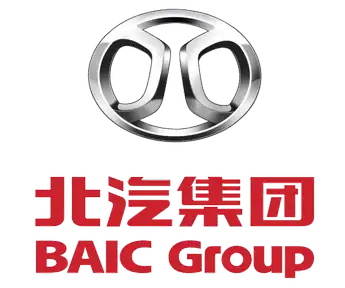

.jpg.webp)

